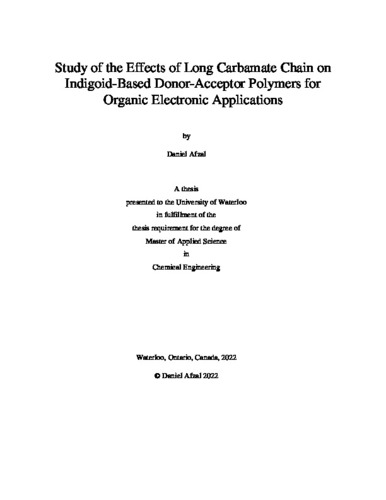| dc.description.abstract | Novel donor-acceptor polymers based on indigoid building blocks, hemi-isoindigo and isoindigo, with the substitution of long carbamate side chains were synthesized for organic solar cells (OSCs) and organic field-effect transistors (OFETs) applications. The effects of the thermo-cleavable carbamate side chain are studied to demonstrate the potential influence on efficiency and performance for solar cell and transistor applications, respectively. Regarding the first topic of this thesis, it addresses third-generation solar cells, organic solar cells as a potential for renewable source of energy due to their advantages of having low cost, light weight, flexibility, and roll-to-roll printing. These organic solar cells (OSCs) encompass a bulk heterojunction model (BHJ) in which the donor polymer and acceptor are used as an active material to achieve high efficiency. Currently, the leading OSCs reach over 18 % with the introduction of non-fullerene acceptors with wide-bandgap polymers. In this work, we introduce a D-A (donor-acceptor) copolymer system where benzodiothiophene is the donor backbone unit combined with the coplanar (Z)-3-(thiophen-2-yl-methylene)-indolin-2- acceptor unit. The acceptor unit consists of an electron-withdrawing carbamate side chain to be used in the wide-bandgap donor polymer system for organic solar cells. It is theorized that the introduction of the carbamate chain will deepen the HOMO level of the polymer to improve the optical bandgap and result in a better VOC. Furthermore, the thermal labile property of the carbamate chain can prove useful for organic solar cells. This is because before removing the chain, it gives a reasonable amount of solubility to the polymer so that it can be processed. Once the polymer is deposited, the chains can be removed by heat as previously studied by our group. This can further improve the polymer’s molecular backbone by making it more coplanar as the bulky groups are removed. This enhances the pi-pi stacking as the charge hoping distance between the individual polymer molecules are increased. All in all, providing a higher FF and JSC. Thus, ultimately increasing overall PCE. Based on the structure alone, 2-decyltetradecyl (Z)-3-((5-(4,8-bis(5-(2-ethylhexyl)thiophen-2- yl)-6-methylbenzo[1,2-b:5,4-b']dithiophen-2-yl)thiophen-2-yl)methylene)-6-methyl-2- oxoindoline-1-carboxylate or TEIBDT exhibits a very coplanar structure useful towards achieving high PCE, has straight-forward synthesis as well as high quenching efficiency making it a promising candidate for OSCs. The solar cell device based on TEIBDT: Y6 blend film showed an adequate efficiency of 8.00% with JSC of 20.60 mAcm-2 , VOC of 0.70 V and FF of 0.56. The carrier mobilities of the film for hole and electron were calculated to be 1.06 x 10-4 cm2V-1s-1 and 8.855 x 10-5 cm2V-1s-1, respectively. The high PCE is attributed to good film morphology with good crystallinity. The second topic of this thesis focuses on the application of organic field-effect transistors. Isoindigo is known for being an excellent acceptor building block for donor-acceptor polymers with the advantages of simple synthesis, excellent air stability and high electrical performance. Thus, in this study, we explore the impact of the thermo-cleavable carbamate chain for the potential enhancement of mobility, solvent resistance, and morphological stability. The theory is that the thermally removable carbamate side chains on the isoindigo unit can help form intermolecular hydrogen bonds, which can afford excellent solvent resistance and morphological stability while also enhancing pi-pi stacking to improve upon charge carrier mobility as the charge hoping distance between the individual polymer molecules are increased. Moreover, this study focuses on three novel isoindigo polymers, PIDMT, PIDBT, and PIDBDT and are evaluated based on their transfer characteristics, mobility, and solvent resistance. With regards to solvent resistance, all the polymers exhibited resistance towards processing solvents such as chloroform and toluene when annealed at 250 ºC. In terms of performance, the PID polymers displayed ambipolar characteristics with p-type mode being the dominant function. The mobility performance for PIDMT, PIDBT and PIDBDT are the following 0.004, 0.01, and 0.007 cm2V-1s-1 , respectively, for p-type and 0.001, 0.004, 0.005 cm2V-1s-1, respectively, for n-type with PIDBT being dominant for both modes. | en |

